CHEERS Statement: Evaluating Health Economics & Resource Allocation
VerifiedAdded on 2023/06/14
|9
|2586
|52
Report
AI Summary
This report evaluates the Consolidated Health Economic Evaluation Reporting Standards (CHEERS) statement and its impact on cost-effectiveness in healthcare resource allocation. It explores the background, objectives, and methods related to CHEERS, including target populations, study settings, comparators, time horizons, and discount rates. The analysis covers the measurement of effectiveness, choice of health outcomes, and various decision-analytical methods like cost-consequence, cost-effectiveness, cost-minimization, and cost-utility analyses. The report also discusses the challenges and uncertainties in health economics evaluation, highlighting the importance of effective resource utilization and the role of funding sources in health interventions. The study emphasizes the need for transparent and standardized reporting to improve the quality and interpretation of health economics evaluations.
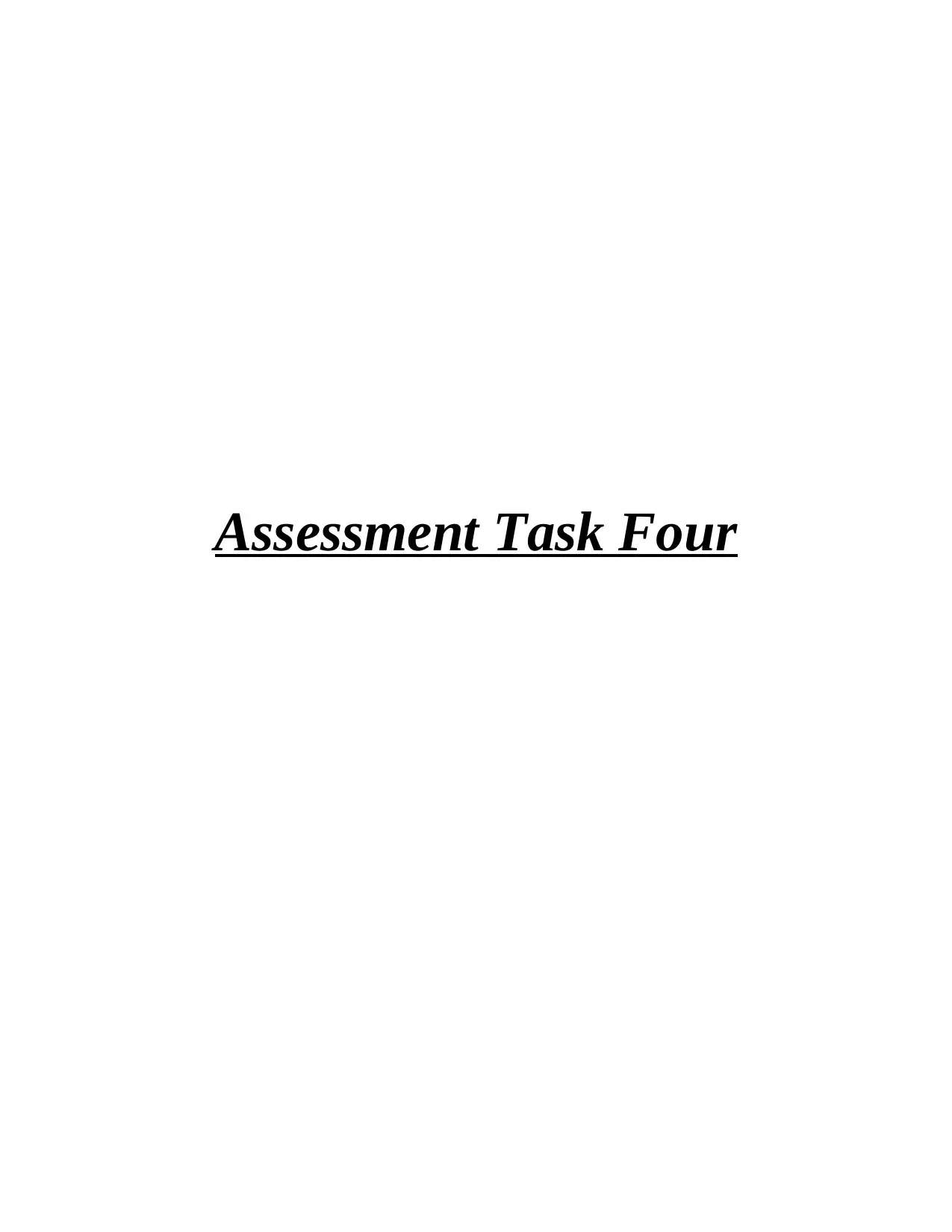
Assessment Task Four
Paraphrase This Document
Need a fresh take? Get an instant paraphrase of this document with our AI Paraphraser
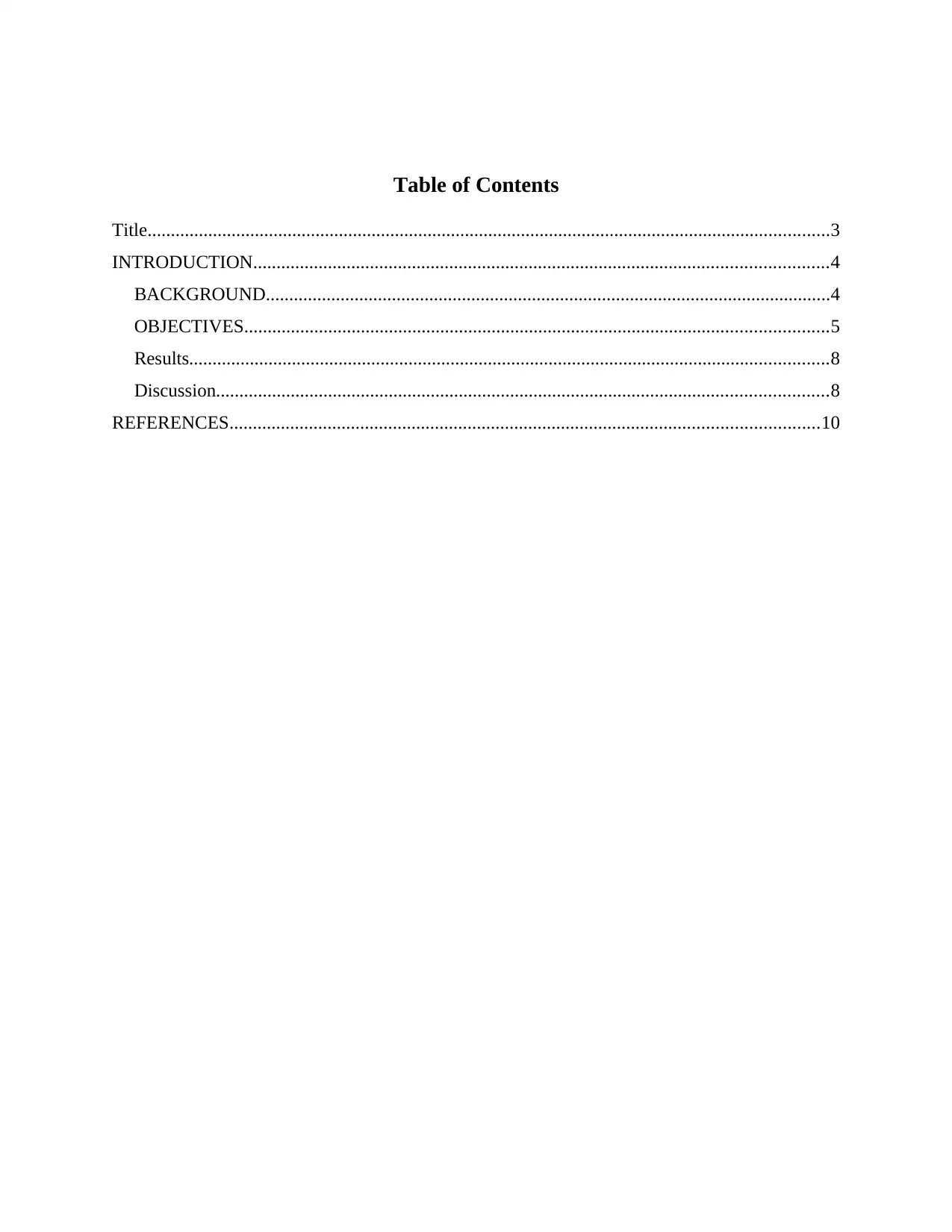
Table of Contents
Title..................................................................................................................................................3
INTRODUCTION...........................................................................................................................4
BACKGROUND.........................................................................................................................4
OBJECTIVES.............................................................................................................................5
Results.........................................................................................................................................8
Discussion...................................................................................................................................8
REFERENCES..............................................................................................................................10
Title..................................................................................................................................................3
INTRODUCTION...........................................................................................................................4
BACKGROUND.........................................................................................................................4
OBJECTIVES.............................................................................................................................5
Results.........................................................................................................................................8
Discussion...................................................................................................................................8
REFERENCES..............................................................................................................................10

Title
To evaluate health economic reporting standard (CHEERS) statement involving cost-
effectiveness of resource allocation.
To evaluate health economic reporting standard (CHEERS) statement involving cost-
effectiveness of resource allocation.
⊘ This is a preview!⊘
Do you want full access?
Subscribe today to unlock all pages.

Trusted by 1+ million students worldwide
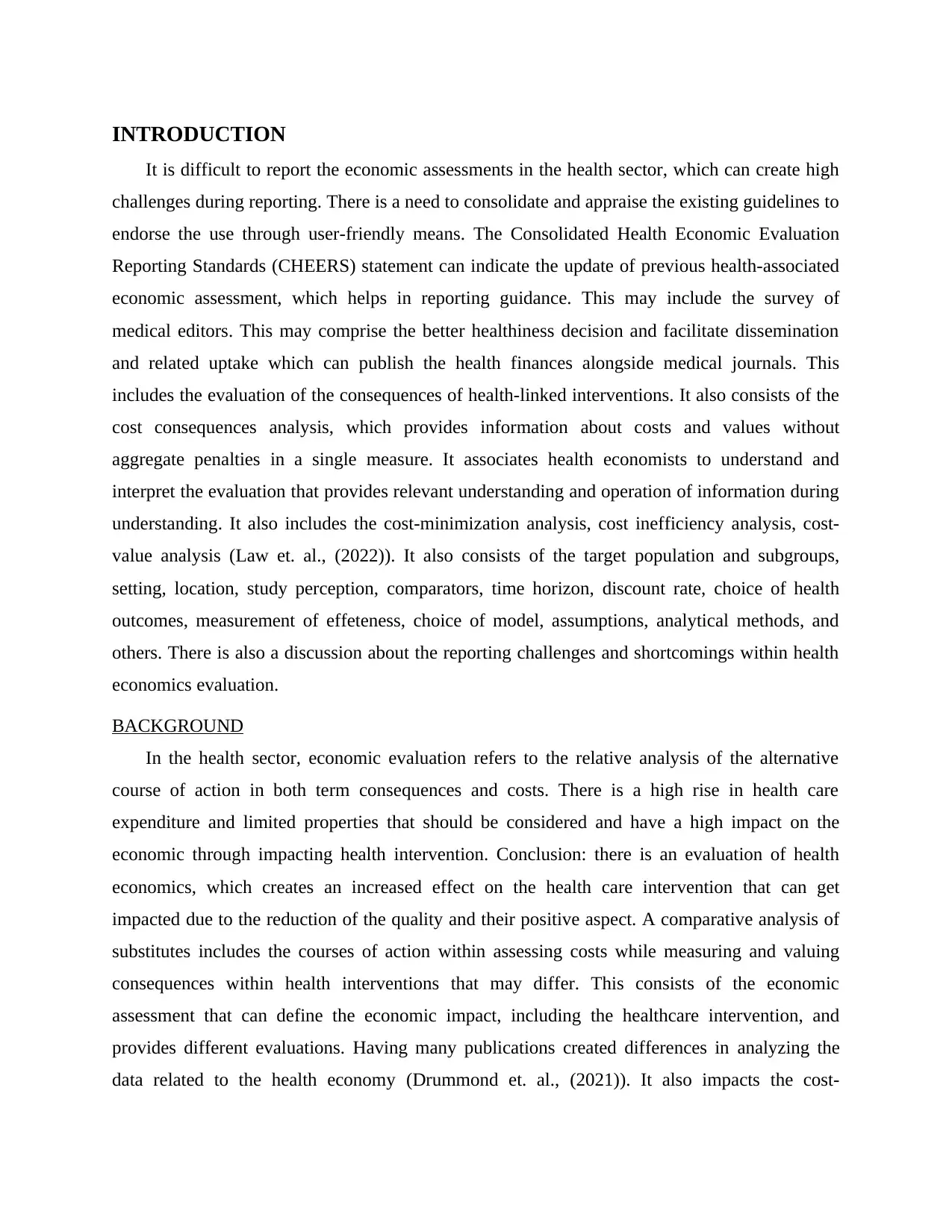
INTRODUCTION
It is difficult to report the economic assessments in the health sector, which can create high
challenges during reporting. There is a need to consolidate and appraise the existing guidelines to
endorse the use through user-friendly means. The Consolidated Health Economic Evaluation
Reporting Standards (CHEERS) statement can indicate the update of previous health-associated
economic assessment, which helps in reporting guidance. This may include the survey of
medical editors. This may comprise the better healthiness decision and facilitate dissemination
and related uptake which can publish the health finances alongside medical journals. This
includes the evaluation of the consequences of health-linked interventions. It also consists of the
cost consequences analysis, which provides information about costs and values without
aggregate penalties in a single measure. It associates health economists to understand and
interpret the evaluation that provides relevant understanding and operation of information during
understanding. It also includes the cost-minimization analysis, cost inefficiency analysis, cost-
value analysis (Law et. al., (2022)). It also consists of the target population and subgroups,
setting, location, study perception, comparators, time horizon, discount rate, choice of health
outcomes, measurement of effeteness, choice of model, assumptions, analytical methods, and
others. There is also a discussion about the reporting challenges and shortcomings within health
economics evaluation.
BACKGROUND
In the health sector, economic evaluation refers to the relative analysis of the alternative
course of action in both term consequences and costs. There is a high rise in health care
expenditure and limited properties that should be considered and have a high impact on the
economic through impacting health intervention. Conclusion: there is an evaluation of health
economics, which creates an increased effect on the health care intervention that can get
impacted due to the reduction of the quality and their positive aspect. A comparative analysis of
substitutes includes the courses of action within assessing costs while measuring and valuing
consequences within health interventions that may differ. This consists of the economic
assessment that can define the economic impact, including the healthcare intervention, and
provides different evaluations. Having many publications created differences in analyzing the
data related to the health economy (Drummond et. al., (2021)). It also impacts the cost-
It is difficult to report the economic assessments in the health sector, which can create high
challenges during reporting. There is a need to consolidate and appraise the existing guidelines to
endorse the use through user-friendly means. The Consolidated Health Economic Evaluation
Reporting Standards (CHEERS) statement can indicate the update of previous health-associated
economic assessment, which helps in reporting guidance. This may include the survey of
medical editors. This may comprise the better healthiness decision and facilitate dissemination
and related uptake which can publish the health finances alongside medical journals. This
includes the evaluation of the consequences of health-linked interventions. It also consists of the
cost consequences analysis, which provides information about costs and values without
aggregate penalties in a single measure. It associates health economists to understand and
interpret the evaluation that provides relevant understanding and operation of information during
understanding. It also includes the cost-minimization analysis, cost inefficiency analysis, cost-
value analysis (Law et. al., (2022)). It also consists of the target population and subgroups,
setting, location, study perception, comparators, time horizon, discount rate, choice of health
outcomes, measurement of effeteness, choice of model, assumptions, analytical methods, and
others. There is also a discussion about the reporting challenges and shortcomings within health
economics evaluation.
BACKGROUND
In the health sector, economic evaluation refers to the relative analysis of the alternative
course of action in both term consequences and costs. There is a high rise in health care
expenditure and limited properties that should be considered and have a high impact on the
economic through impacting health intervention. Conclusion: there is an evaluation of health
economics, which creates an increased effect on the health care intervention that can get
impacted due to the reduction of the quality and their positive aspect. A comparative analysis of
substitutes includes the courses of action within assessing costs while measuring and valuing
consequences within health interventions that may differ. This consists of the economic
assessment that can define the economic impact, including the healthcare intervention, and
provides different evaluations. Having many publications created differences in analyzing the
data related to the health economy (Drummond et. al., (2021)). It also impacts the cost-
Paraphrase This Document
Need a fresh take? Get an instant paraphrase of this document with our AI Paraphraser
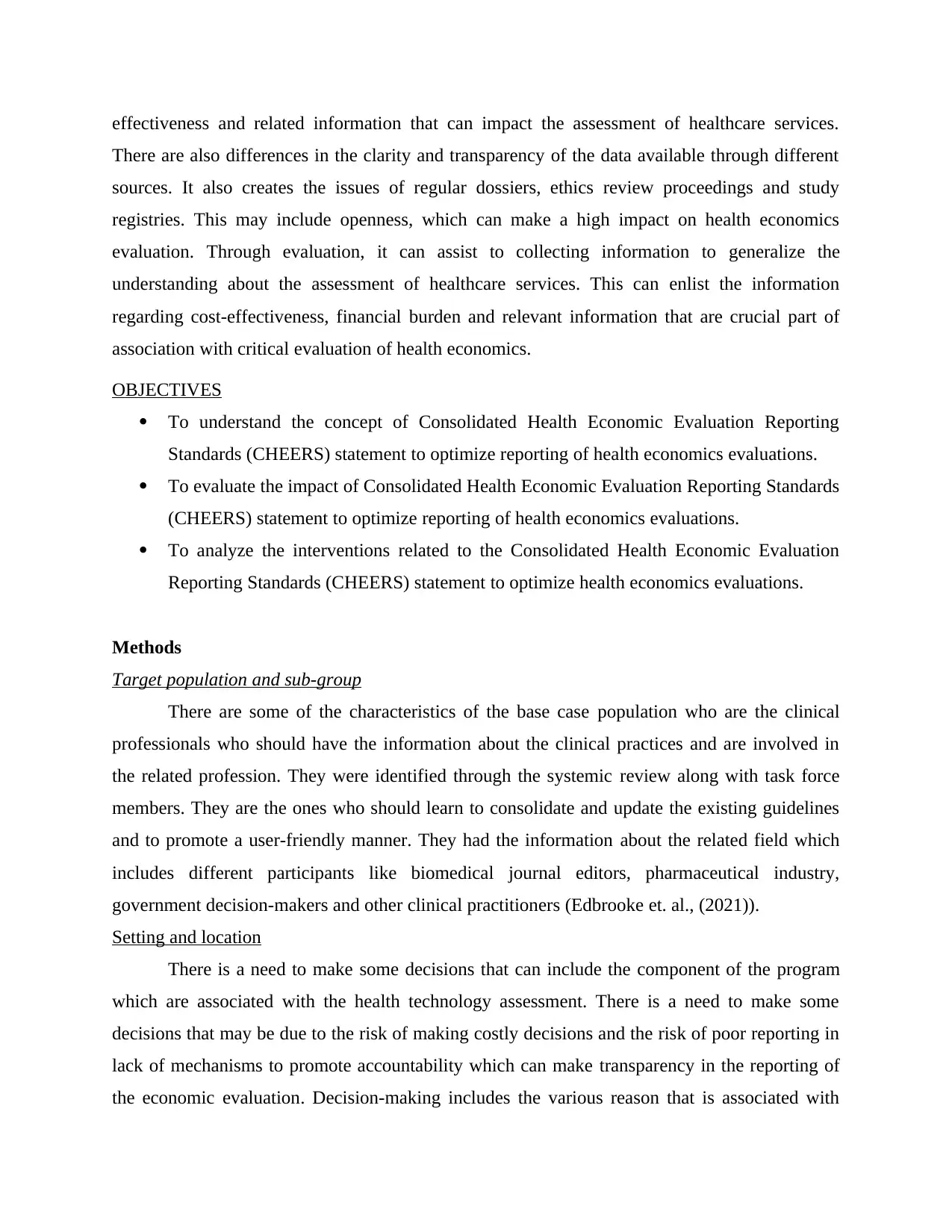
effectiveness and related information that can impact the assessment of healthcare services.
There are also differences in the clarity and transparency of the data available through different
sources. It also creates the issues of regular dossiers, ethics review proceedings and study
registries. This may include openness, which can make a high impact on health economics
evaluation. Through evaluation, it can assist to collecting information to generalize the
understanding about the assessment of healthcare services. This can enlist the information
regarding cost-effectiveness, financial burden and relevant information that are crucial part of
association with critical evaluation of health economics.
OBJECTIVES
To understand the concept of Consolidated Health Economic Evaluation Reporting
Standards (CHEERS) statement to optimize reporting of health economics evaluations.
To evaluate the impact of Consolidated Health Economic Evaluation Reporting Standards
(CHEERS) statement to optimize reporting of health economics evaluations.
To analyze the interventions related to the Consolidated Health Economic Evaluation
Reporting Standards (CHEERS) statement to optimize health economics evaluations.
Methods
Target population and sub-group
There are some of the characteristics of the base case population who are the clinical
professionals who should have the information about the clinical practices and are involved in
the related profession. They were identified through the systemic review along with task force
members. They are the ones who should learn to consolidate and update the existing guidelines
and to promote a user-friendly manner. They had the information about the related field which
includes different participants like biomedical journal editors, pharmaceutical industry,
government decision-makers and other clinical practitioners (Edbrooke et. al., (2021)).
Setting and location
There is a need to make some decisions that can include the component of the program
which are associated with the health technology assessment. There is a need to make some
decisions that may be due to the risk of making costly decisions and the risk of poor reporting in
lack of mechanisms to promote accountability which can make transparency in the reporting of
the economic evaluation. Decision-making includes the various reason that is associated with
There are also differences in the clarity and transparency of the data available through different
sources. It also creates the issues of regular dossiers, ethics review proceedings and study
registries. This may include openness, which can make a high impact on health economics
evaluation. Through evaluation, it can assist to collecting information to generalize the
understanding about the assessment of healthcare services. This can enlist the information
regarding cost-effectiveness, financial burden and relevant information that are crucial part of
association with critical evaluation of health economics.
OBJECTIVES
To understand the concept of Consolidated Health Economic Evaluation Reporting
Standards (CHEERS) statement to optimize reporting of health economics evaluations.
To evaluate the impact of Consolidated Health Economic Evaluation Reporting Standards
(CHEERS) statement to optimize reporting of health economics evaluations.
To analyze the interventions related to the Consolidated Health Economic Evaluation
Reporting Standards (CHEERS) statement to optimize health economics evaluations.
Methods
Target population and sub-group
There are some of the characteristics of the base case population who are the clinical
professionals who should have the information about the clinical practices and are involved in
the related profession. They were identified through the systemic review along with task force
members. They are the ones who should learn to consolidate and update the existing guidelines
and to promote a user-friendly manner. They had the information about the related field which
includes different participants like biomedical journal editors, pharmaceutical industry,
government decision-makers and other clinical practitioners (Edbrooke et. al., (2021)).
Setting and location
There is a need to make some decisions that can include the component of the program
which are associated with the health technology assessment. There is a need to make some
decisions that may be due to the risk of making costly decisions and the risk of poor reporting in
lack of mechanisms to promote accountability which can make transparency in the reporting of
the economic evaluation. Decision-making includes the various reason that is associated with
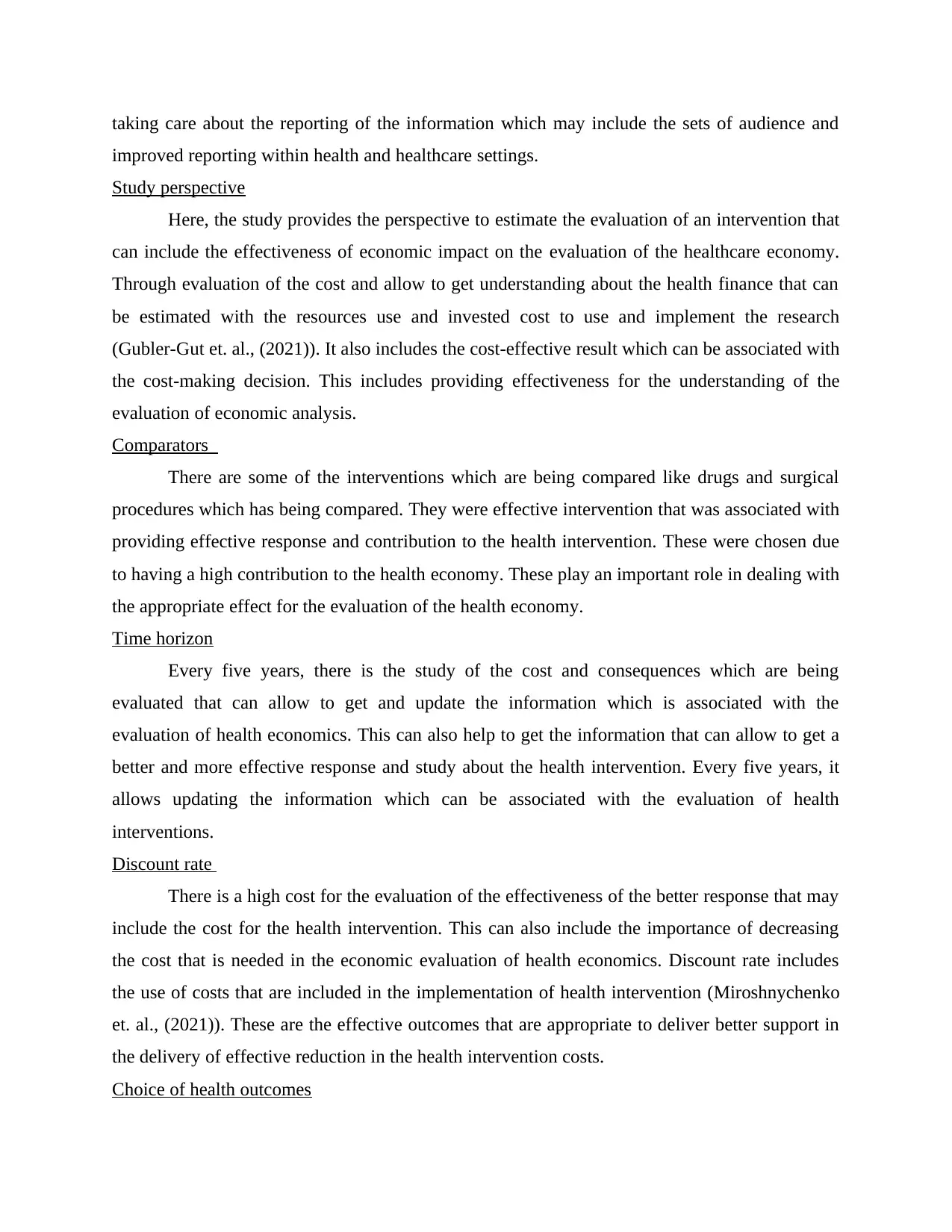
taking care about the reporting of the information which may include the sets of audience and
improved reporting within health and healthcare settings.
Study perspective
Here, the study provides the perspective to estimate the evaluation of an intervention that
can include the effectiveness of economic impact on the evaluation of the healthcare economy.
Through evaluation of the cost and allow to get understanding about the health finance that can
be estimated with the resources use and invested cost to use and implement the research
(Gubler-Gut et. al., (2021)). It also includes the cost-effective result which can be associated with
the cost-making decision. This includes providing effectiveness for the understanding of the
evaluation of economic analysis.
Comparators
There are some of the interventions which are being compared like drugs and surgical
procedures which has being compared. They were effective intervention that was associated with
providing effective response and contribution to the health intervention. These were chosen due
to having a high contribution to the health economy. These play an important role in dealing with
the appropriate effect for the evaluation of the health economy.
Time horizon
Every five years, there is the study of the cost and consequences which are being
evaluated that can allow to get and update the information which is associated with the
evaluation of health economics. This can also help to get the information that can allow to get a
better and more effective response and study about the health intervention. Every five years, it
allows updating the information which can be associated with the evaluation of health
interventions.
Discount rate
There is a high cost for the evaluation of the effectiveness of the better response that may
include the cost for the health intervention. This can also include the importance of decreasing
the cost that is needed in the economic evaluation of health economics. Discount rate includes
the use of costs that are included in the implementation of health intervention (Miroshnychenko
et. al., (2021)). These are the effective outcomes that are appropriate to deliver better support in
the delivery of effective reduction in the health intervention costs.
Choice of health outcomes
improved reporting within health and healthcare settings.
Study perspective
Here, the study provides the perspective to estimate the evaluation of an intervention that
can include the effectiveness of economic impact on the evaluation of the healthcare economy.
Through evaluation of the cost and allow to get understanding about the health finance that can
be estimated with the resources use and invested cost to use and implement the research
(Gubler-Gut et. al., (2021)). It also includes the cost-effective result which can be associated with
the cost-making decision. This includes providing effectiveness for the understanding of the
evaluation of economic analysis.
Comparators
There are some of the interventions which are being compared like drugs and surgical
procedures which has being compared. They were effective intervention that was associated with
providing effective response and contribution to the health intervention. These were chosen due
to having a high contribution to the health economy. These play an important role in dealing with
the appropriate effect for the evaluation of the health economy.
Time horizon
Every five years, there is the study of the cost and consequences which are being
evaluated that can allow to get and update the information which is associated with the
evaluation of health economics. This can also help to get the information that can allow to get a
better and more effective response and study about the health intervention. Every five years, it
allows updating the information which can be associated with the evaluation of health
interventions.
Discount rate
There is a high cost for the evaluation of the effectiveness of the better response that may
include the cost for the health intervention. This can also include the importance of decreasing
the cost that is needed in the economic evaluation of health economics. Discount rate includes
the use of costs that are included in the implementation of health intervention (Miroshnychenko
et. al., (2021)). These are the effective outcomes that are appropriate to deliver better support in
the delivery of effective reduction in the health intervention costs.
Choice of health outcomes
⊘ This is a preview!⊘
Do you want full access?
Subscribe today to unlock all pages.

Trusted by 1+ million students worldwide
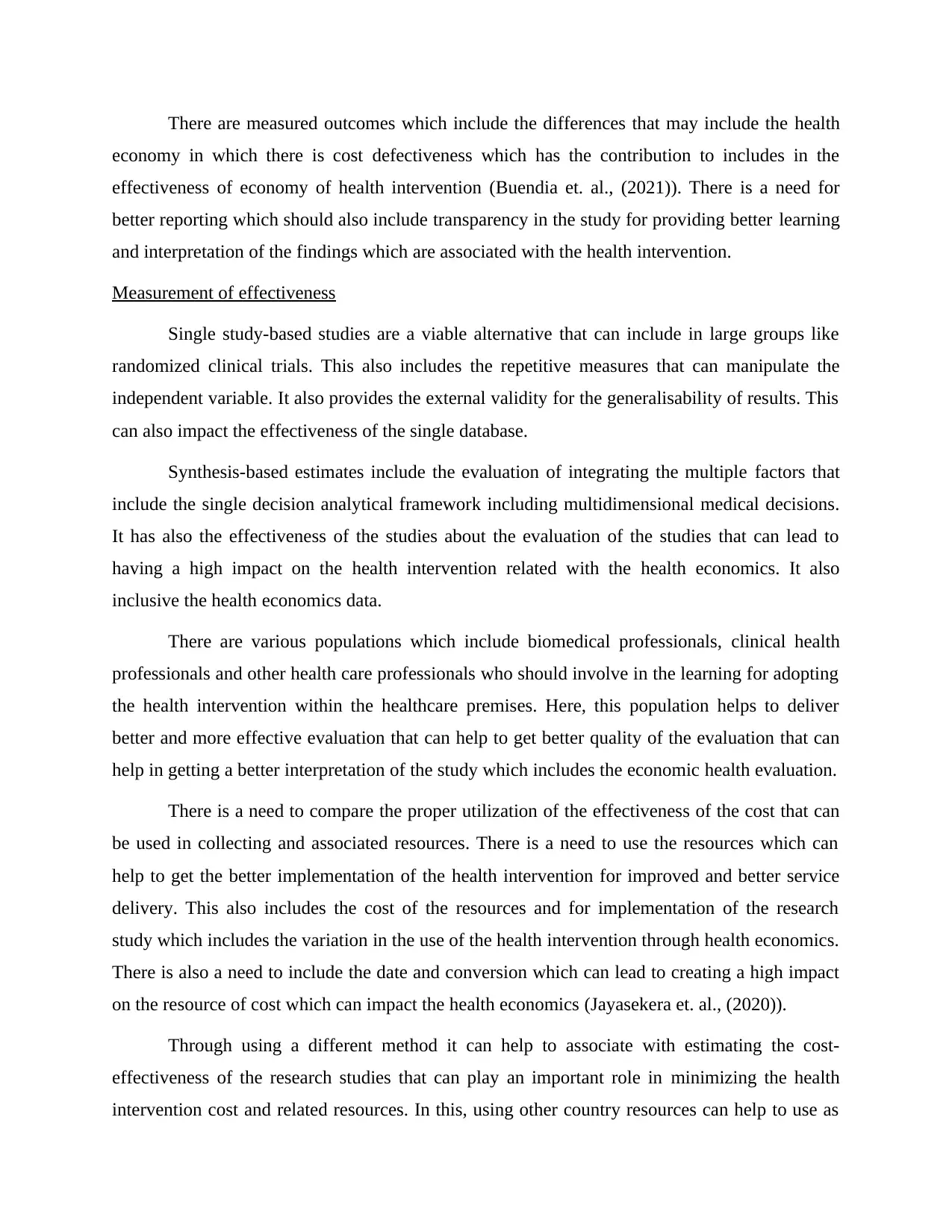
There are measured outcomes which include the differences that may include the health
economy in which there is cost defectiveness which has the contribution to includes in the
effectiveness of economy of health intervention (Buendia et. al., (2021)). There is a need for
better reporting which should also include transparency in the study for providing better learning
and interpretation of the findings which are associated with the health intervention.
Measurement of effectiveness
Single study-based studies are a viable alternative that can include in large groups like
randomized clinical trials. This also includes the repetitive measures that can manipulate the
independent variable. It also provides the external validity for the generalisability of results. This
can also impact the effectiveness of the single database.
Synthesis-based estimates include the evaluation of integrating the multiple factors that
include the single decision analytical framework including multidimensional medical decisions.
It has also the effectiveness of the studies about the evaluation of the studies that can lead to
having a high impact on the health intervention related with the health economics. It also
inclusive the health economics data.
There are various populations which include biomedical professionals, clinical health
professionals and other health care professionals who should involve in the learning for adopting
the health intervention within the healthcare premises. Here, this population helps to deliver
better and more effective evaluation that can help to get better quality of the evaluation that can
help in getting a better interpretation of the study which includes the economic health evaluation.
There is a need to compare the proper utilization of the effectiveness of the cost that can
be used in collecting and associated resources. There is a need to use the resources which can
help to get the better implementation of the health intervention for improved and better service
delivery. This also includes the cost of the resources and for implementation of the research
study which includes the variation in the use of the health intervention through health economics.
There is also a need to include the date and conversion which can lead to creating a high impact
on the resource of cost which can impact the health economics (Jayasekera et. al., (2020)).
Through using a different method it can help to associate with estimating the cost-
effectiveness of the research studies that can play an important role in minimizing the health
intervention cost and related resources. In this, using other country resources can help to use as
economy in which there is cost defectiveness which has the contribution to includes in the
effectiveness of economy of health intervention (Buendia et. al., (2021)). There is a need for
better reporting which should also include transparency in the study for providing better learning
and interpretation of the findings which are associated with the health intervention.
Measurement of effectiveness
Single study-based studies are a viable alternative that can include in large groups like
randomized clinical trials. This also includes the repetitive measures that can manipulate the
independent variable. It also provides the external validity for the generalisability of results. This
can also impact the effectiveness of the single database.
Synthesis-based estimates include the evaluation of integrating the multiple factors that
include the single decision analytical framework including multidimensional medical decisions.
It has also the effectiveness of the studies about the evaluation of the studies that can lead to
having a high impact on the health intervention related with the health economics. It also
inclusive the health economics data.
There are various populations which include biomedical professionals, clinical health
professionals and other health care professionals who should involve in the learning for adopting
the health intervention within the healthcare premises. Here, this population helps to deliver
better and more effective evaluation that can help to get better quality of the evaluation that can
help in getting a better interpretation of the study which includes the economic health evaluation.
There is a need to compare the proper utilization of the effectiveness of the cost that can
be used in collecting and associated resources. There is a need to use the resources which can
help to get the better implementation of the health intervention for improved and better service
delivery. This also includes the cost of the resources and for implementation of the research
study which includes the variation in the use of the health intervention through health economics.
There is also a need to include the date and conversion which can lead to creating a high impact
on the resource of cost which can impact the health economics (Jayasekera et. al., (2020)).
Through using a different method it can help to associate with estimating the cost-
effectiveness of the research studies that can play an important role in minimizing the health
intervention cost and related resources. In this, using other country resources can help to use as
Paraphrase This Document
Need a fresh take? Get an instant paraphrase of this document with our AI Paraphraser
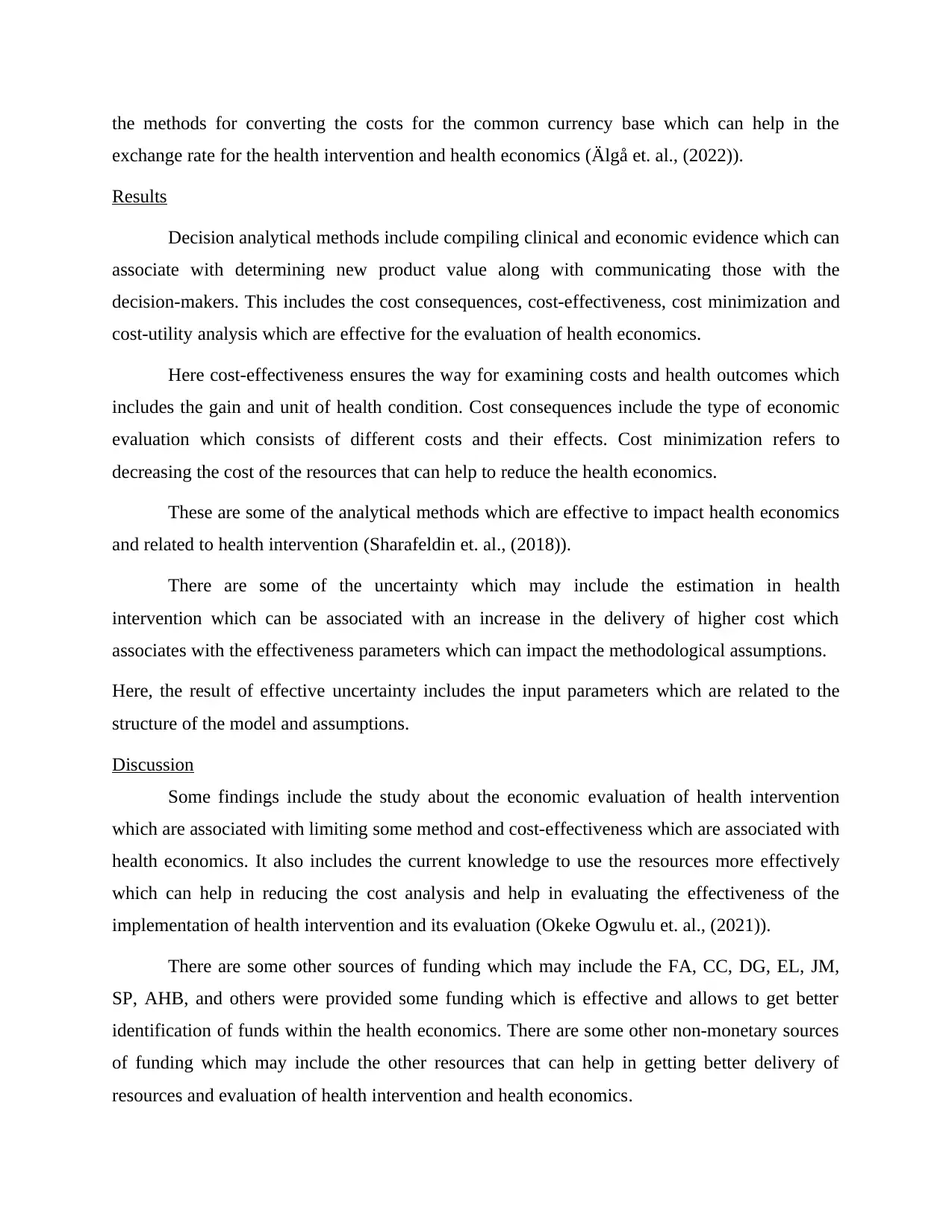
the methods for converting the costs for the common currency base which can help in the
exchange rate for the health intervention and health economics (Älgå et. al., (2022)).
Results
Decision analytical methods include compiling clinical and economic evidence which can
associate with determining new product value along with communicating those with the
decision-makers. This includes the cost consequences, cost-effectiveness, cost minimization and
cost-utility analysis which are effective for the evaluation of health economics.
Here cost-effectiveness ensures the way for examining costs and health outcomes which
includes the gain and unit of health condition. Cost consequences include the type of economic
evaluation which consists of different costs and their effects. Cost minimization refers to
decreasing the cost of the resources that can help to reduce the health economics.
These are some of the analytical methods which are effective to impact health economics
and related to health intervention (Sharafeldin et. al., (2018)).
There are some of the uncertainty which may include the estimation in health
intervention which can be associated with an increase in the delivery of higher cost which
associates with the effectiveness parameters which can impact the methodological assumptions.
Here, the result of effective uncertainty includes the input parameters which are related to the
structure of the model and assumptions.
Discussion
Some findings include the study about the economic evaluation of health intervention
which are associated with limiting some method and cost-effectiveness which are associated with
health economics. It also includes the current knowledge to use the resources more effectively
which can help in reducing the cost analysis and help in evaluating the effectiveness of the
implementation of health intervention and its evaluation (Okeke Ogwulu et. al., (2021)).
There are some other sources of funding which may include the FA, CC, DG, EL, JM,
SP, AHB, and others were provided some funding which is effective and allows to get better
identification of funds within the health economics. There are some other non-monetary sources
of funding which may include the other resources that can help in getting better delivery of
resources and evaluation of health intervention and health economics.
exchange rate for the health intervention and health economics (Älgå et. al., (2022)).
Results
Decision analytical methods include compiling clinical and economic evidence which can
associate with determining new product value along with communicating those with the
decision-makers. This includes the cost consequences, cost-effectiveness, cost minimization and
cost-utility analysis which are effective for the evaluation of health economics.
Here cost-effectiveness ensures the way for examining costs and health outcomes which
includes the gain and unit of health condition. Cost consequences include the type of economic
evaluation which consists of different costs and their effects. Cost minimization refers to
decreasing the cost of the resources that can help to reduce the health economics.
These are some of the analytical methods which are effective to impact health economics
and related to health intervention (Sharafeldin et. al., (2018)).
There are some of the uncertainty which may include the estimation in health
intervention which can be associated with an increase in the delivery of higher cost which
associates with the effectiveness parameters which can impact the methodological assumptions.
Here, the result of effective uncertainty includes the input parameters which are related to the
structure of the model and assumptions.
Discussion
Some findings include the study about the economic evaluation of health intervention
which are associated with limiting some method and cost-effectiveness which are associated with
health economics. It also includes the current knowledge to use the resources more effectively
which can help in reducing the cost analysis and help in evaluating the effectiveness of the
implementation of health intervention and its evaluation (Okeke Ogwulu et. al., (2021)).
There are some other sources of funding which may include the FA, CC, DG, EL, JM,
SP, AHB, and others were provided some funding which is effective and allows to get better
identification of funds within the health economics. There are some other non-monetary sources
of funding which may include the other resources that can help in getting better delivery of
resources and evaluation of health intervention and health economics.
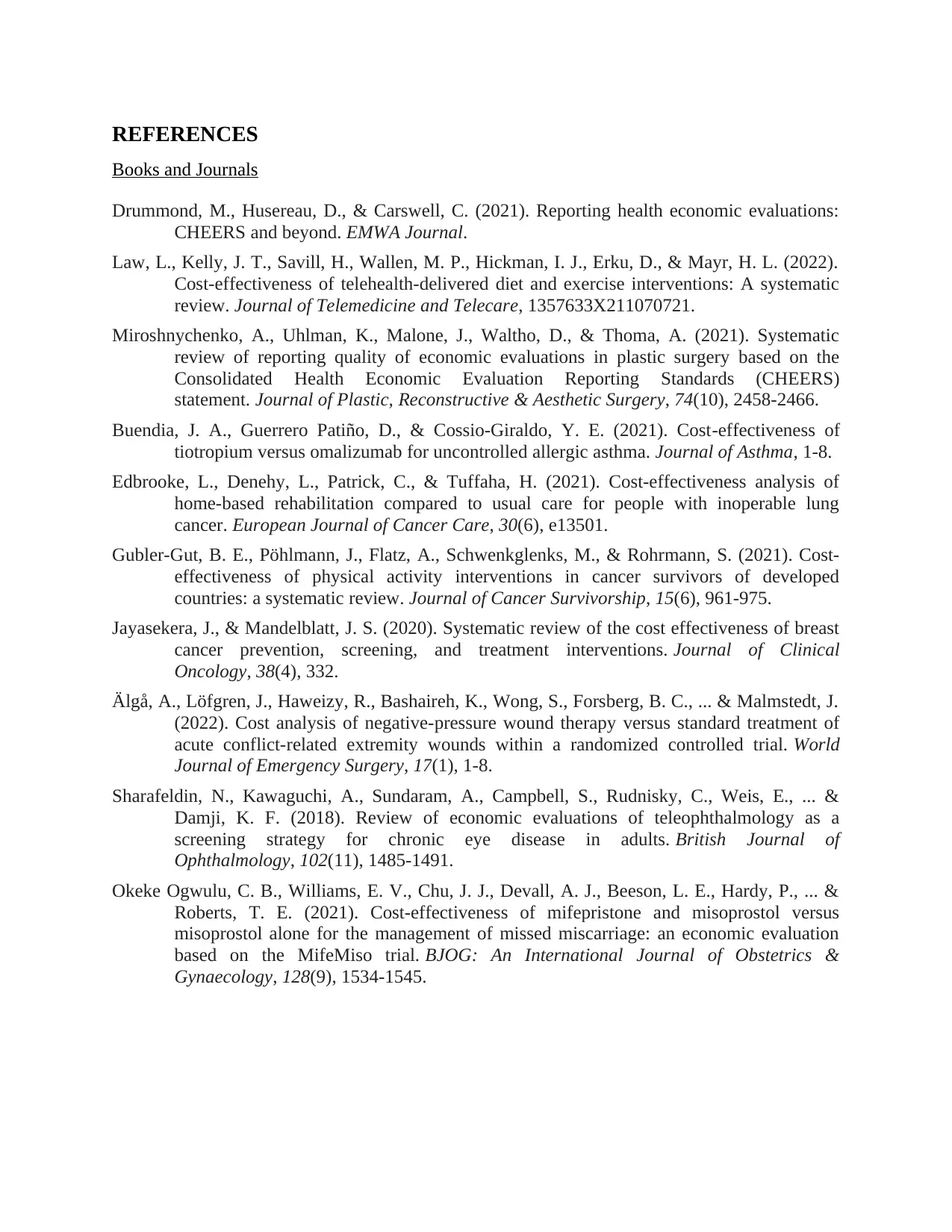
REFERENCES
Books and Journals
Drummond, M., Husereau, D., & Carswell, C. (2021). Reporting health economic evaluations:
CHEERS and beyond. EMWA Journal.
Law, L., Kelly, J. T., Savill, H., Wallen, M. P., Hickman, I. J., Erku, D., & Mayr, H. L. (2022).
Cost-effectiveness of telehealth-delivered diet and exercise interventions: A systematic
review. Journal of Telemedicine and Telecare, 1357633X211070721.
Miroshnychenko, A., Uhlman, K., Malone, J., Waltho, D., & Thoma, A. (2021). Systematic
review of reporting quality of economic evaluations in plastic surgery based on the
Consolidated Health Economic Evaluation Reporting Standards (CHEERS)
statement. Journal of Plastic, Reconstructive & Aesthetic Surgery, 74(10), 2458-2466.
Buendia, J. A., Guerrero Patiño, D., & Cossio-Giraldo, Y. E. (2021). Cost-effectiveness of
tiotropium versus omalizumab for uncontrolled allergic asthma. Journal of Asthma, 1-8.
Edbrooke, L., Denehy, L., Patrick, C., & Tuffaha, H. (2021). Cost‐effectiveness analysis of
home‐based rehabilitation compared to usual care for people with inoperable lung
cancer. European Journal of Cancer Care, 30(6), e13501.
Gubler-Gut, B. E., Pöhlmann, J., Flatz, A., Schwenkglenks, M., & Rohrmann, S. (2021). Cost-
effectiveness of physical activity interventions in cancer survivors of developed
countries: a systematic review. Journal of Cancer Survivorship, 15(6), 961-975.
Jayasekera, J., & Mandelblatt, J. S. (2020). Systematic review of the cost effectiveness of breast
cancer prevention, screening, and treatment interventions. Journal of Clinical
Oncology, 38(4), 332.
Älgå, A., Löfgren, J., Haweizy, R., Bashaireh, K., Wong, S., Forsberg, B. C., ... & Malmstedt, J.
(2022). Cost analysis of negative-pressure wound therapy versus standard treatment of
acute conflict-related extremity wounds within a randomized controlled trial. World
Journal of Emergency Surgery, 17(1), 1-8.
Sharafeldin, N., Kawaguchi, A., Sundaram, A., Campbell, S., Rudnisky, C., Weis, E., ... &
Damji, K. F. (2018). Review of economic evaluations of teleophthalmology as a
screening strategy for chronic eye disease in adults. British Journal of
Ophthalmology, 102(11), 1485-1491.
Okeke Ogwulu, C. B., Williams, E. V., Chu, J. J., Devall, A. J., Beeson, L. E., Hardy, P., ... &
Roberts, T. E. (2021). Cost‐effectiveness of mifepristone and misoprostol versus
misoprostol alone for the management of missed miscarriage: an economic evaluation
based on the MifeMiso trial. BJOG: An International Journal of Obstetrics &
Gynaecology, 128(9), 1534-1545.
Books and Journals
Drummond, M., Husereau, D., & Carswell, C. (2021). Reporting health economic evaluations:
CHEERS and beyond. EMWA Journal.
Law, L., Kelly, J. T., Savill, H., Wallen, M. P., Hickman, I. J., Erku, D., & Mayr, H. L. (2022).
Cost-effectiveness of telehealth-delivered diet and exercise interventions: A systematic
review. Journal of Telemedicine and Telecare, 1357633X211070721.
Miroshnychenko, A., Uhlman, K., Malone, J., Waltho, D., & Thoma, A. (2021). Systematic
review of reporting quality of economic evaluations in plastic surgery based on the
Consolidated Health Economic Evaluation Reporting Standards (CHEERS)
statement. Journal of Plastic, Reconstructive & Aesthetic Surgery, 74(10), 2458-2466.
Buendia, J. A., Guerrero Patiño, D., & Cossio-Giraldo, Y. E. (2021). Cost-effectiveness of
tiotropium versus omalizumab for uncontrolled allergic asthma. Journal of Asthma, 1-8.
Edbrooke, L., Denehy, L., Patrick, C., & Tuffaha, H. (2021). Cost‐effectiveness analysis of
home‐based rehabilitation compared to usual care for people with inoperable lung
cancer. European Journal of Cancer Care, 30(6), e13501.
Gubler-Gut, B. E., Pöhlmann, J., Flatz, A., Schwenkglenks, M., & Rohrmann, S. (2021). Cost-
effectiveness of physical activity interventions in cancer survivors of developed
countries: a systematic review. Journal of Cancer Survivorship, 15(6), 961-975.
Jayasekera, J., & Mandelblatt, J. S. (2020). Systematic review of the cost effectiveness of breast
cancer prevention, screening, and treatment interventions. Journal of Clinical
Oncology, 38(4), 332.
Älgå, A., Löfgren, J., Haweizy, R., Bashaireh, K., Wong, S., Forsberg, B. C., ... & Malmstedt, J.
(2022). Cost analysis of negative-pressure wound therapy versus standard treatment of
acute conflict-related extremity wounds within a randomized controlled trial. World
Journal of Emergency Surgery, 17(1), 1-8.
Sharafeldin, N., Kawaguchi, A., Sundaram, A., Campbell, S., Rudnisky, C., Weis, E., ... &
Damji, K. F. (2018). Review of economic evaluations of teleophthalmology as a
screening strategy for chronic eye disease in adults. British Journal of
Ophthalmology, 102(11), 1485-1491.
Okeke Ogwulu, C. B., Williams, E. V., Chu, J. J., Devall, A. J., Beeson, L. E., Hardy, P., ... &
Roberts, T. E. (2021). Cost‐effectiveness of mifepristone and misoprostol versus
misoprostol alone for the management of missed miscarriage: an economic evaluation
based on the MifeMiso trial. BJOG: An International Journal of Obstetrics &
Gynaecology, 128(9), 1534-1545.
⊘ This is a preview!⊘
Do you want full access?
Subscribe today to unlock all pages.

Trusted by 1+ million students worldwide
1 out of 9
Related Documents
Your All-in-One AI-Powered Toolkit for Academic Success.
+13062052269
info@desklib.com
Available 24*7 on WhatsApp / Email
![[object Object]](/_next/static/media/star-bottom.7253800d.svg)
Unlock your academic potential
Copyright © 2020–2025 A2Z Services. All Rights Reserved. Developed and managed by ZUCOL.





